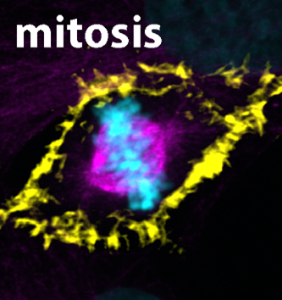Czech-German collaboration revealed breakthrough observations in division of human cells
Tue Jul 16 09:08:20 CEST 2024
Tue Jul 16 09:08:20 CEST 2024 | Tue Jul 16 09:08:20 CEST 2024 - Tue Jul 16 09:08:20 CEST 2024

International research team led by Libor Macurek (Institute of Molecular Genetics, Czech Academy of Sciences), Robert Grosse (Institute for Clinical and Experimental Pharmacology and Toxicology, University of Freiburg) and Zdenek Lansky (Institute of Biotechnology, Czech Academy of Sciences) identified a new mechanism of the crosstalk between microtubules and actin cytoskeleton during cell division. These breakthrough observations have recently been published in Proceedings of the National Academy of Sciences.
Precise segregation of the genetic information into daughter cells is essential in all tissues of our bodies. This process needs to be tightly regulated in space and time to prevent developmental disorders and cancer. It has been known for decades that chromosomes attach to a beautiful bipolar structure called mitotic spindle that is composed of microtubules. As mitosis proceeds, the attached chromosomes are pulled along the microtubule railways to the daughter cells.
Until recently, the scientists believed that actin filaments are needed only for the final step of daughter cell separation and the role of actin cytoskeleton in mitosis has long been neglected. We have now identified a so far unexplored protein FAM110A that binds actin and microtubules by its both ends and it does so at poles of the mitotic spindles. The microscopic analysis revealed formation of highly dynamic actin filaments around the spindle poles that precede and guide the growth of spindle microtubules. In the absence of FAM110A, spindle actin was not formed properly and chromosomal segregation was heavily impaired.
“Thanks to the collaboration with colleagues in Germany, who are experts in imaging of highly dynamic processes in living cells, we have identified a crucial molecular link between the two major cytoskeletal networks in mitosis. In this multidisciplinary project, Zdenek Lansky and his team addressed biophysical properties of the purified proteins in vitro and thus helped us nail down the precise function of FAM110A. In the future, we will investigate how FAM110A and similar proteins present in human cells prevent genome instability and cancer development,” said Libor Macurek.
Link to the publication:
Aquino-Perez C, Safaralizade M, Podhajecky R, Wang H, Lansky Z, Grosse R, Macurek L. FAM110A promotes mitotic spindle formation by linking microtubules with actin cytoskeleton. Proc Natl Acad Sci U S A. 2024 Jul 16;121(29):e2321647121. doi: 10.1073/pnas.2321647121
https://www.pnas.org/doi/10.1073/pnas.2321647121
Source: AV ČR
